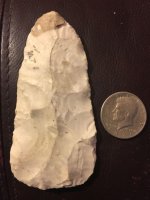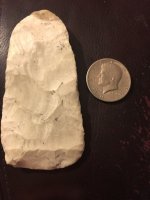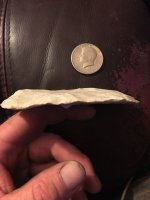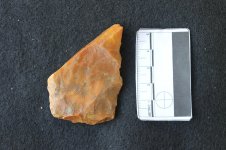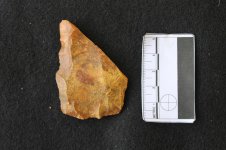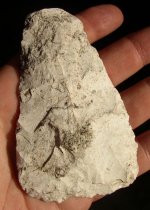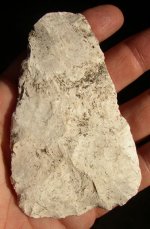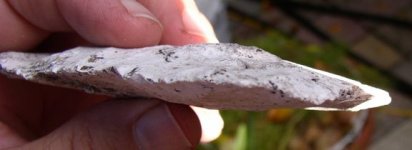Navigation
Install the app
How to install the app on iOS
Follow along with the video below to see how to install our site as a web app on your home screen.
Note: This feature may not be available in some browsers.
More options
You are using an out of date browser. It may not display this or other websites correctly.
You should upgrade or use an alternative browser.
You should upgrade or use an alternative browser.
What is it?
- Thread starter dsmikle
- Start date
sandchip
Silver Member
- Oct 29, 2010
- 4,357
- 6,890
- Detector(s) used
- Teknetics T2SE
- Primary Interest:
- All Treasure Hunting
In the first picture, it looks like an unnotched Hopewell blade, but I agree that after seeing it from the edge that it looks like something else. I'm sure that some more knowledgeable than myself will help you out. Very nice piece.
tamrock
Gold Member
- Jan 16, 2013
- 15,479
- 31,462
- Detector(s) used
- Bounty Hunter Tracker IV
- Primary Interest:
- All Treasure Hunting
Nice artifact. I'd call it a scraper also, but I'm thinking others might label it with another description. My cousin found a nice long notched point about the same size that looks to be made of the very same material at Red Rocks reservoir in Iowa.
dsmikle
Full Member
- Apr 7, 2018
- 172
- 714
- Detector(s) used
- Garrett At Pro Minelab X-Terra 705
- Primary Interest:
- All Treasure Hunting
- Thread starter
- #4
Webster county Missouri Panther creek.
I have found several nice ones in same 30 foot circle there is a patch of small gravel in the middle every time ground is turned I will find a smoker there. Long occupation site stretches for a good 1/4 mile along the creek. Has a small rise that leads into steep hill gravel patch is in the middle of rise. The lower ground you will find 1 out of 20 that’s decent. On that small rise the workmanship is a step or two above lower ground. I have always wondered why the gravel was put there.
I have found several nice ones in same 30 foot circle there is a patch of small gravel in the middle every time ground is turned I will find a smoker there. Long occupation site stretches for a good 1/4 mile along the creek. Has a small rise that leads into steep hill gravel patch is in the middle of rise. The lower ground you will find 1 out of 20 that’s decent. On that small rise the workmanship is a step or two above lower ground. I have always wondered why the gravel was put there.
tomclark
Bronze Member
- Dec 18, 2006
- 1,177
- 1,641
- Detector(s) used
- ShadowX2, TEJON, Eyes, Pony Shovel
- Primary Interest:
- Other
looks like a chipped, hafted adze....
americanartifacts33
Full Member
- Jul 11, 2013
- 227
- 779
- Detector(s) used
- Whites Prism IV
- Primary Interest:
- All Treasure Hunting
Looks like an Adze to me. Very nice find
Tdog
Silver Member
Adze IMO
The Grim Reaper
Gold Member
looks like a chipped, hafted adze....
I agree. Nice one too.
joshuaream
Silver Member
It's pretty big for a scraper and doesn't really look like the flint adzes I've seen from Missouri. (Many of them are thicker than that.)
I'd call it a biface.
You see that curvature on pieces for a couple of reasons, the most common is that it was just made on a thinner spall of chert that had some curve to it. They maximized the length and ended up with a slightly bent piece. It could also be that it's a preform and they were going to do something with the base. You often see an bottom edge that is going to be flaked (fluted, notched, etc.) angled with an edge below the plane of the middle of the blade. Beveled for lack of a better term. Here are two pictures of a fluted point base from my collection that shows it. (I don't think the original relic here was going to be a fluted point, but maybe notched like a Smith or something.)
I'd call it a biface.
You see that curvature on pieces for a couple of reasons, the most common is that it was just made on a thinner spall of chert that had some curve to it. They maximized the length and ended up with a slightly bent piece. It could also be that it's a preform and they were going to do something with the base. You often see an bottom edge that is going to be flaked (fluted, notched, etc.) angled with an edge below the plane of the middle of the blade. Beveled for lack of a better term. Here are two pictures of a fluted point base from my collection that shows it. (I don't think the original relic here was going to be a fluted point, but maybe notched like a Smith or something.)
Attachments
uniface
Silver Member
That angled base is a Clovis preform strategy, but by no means was it exclusive to Clovis, so it's not much help in and of itself.
FWIW
FWIW
tomclark
Bronze Member
- Dec 18, 2006
- 1,177
- 1,641
- Detector(s) used
- ShadowX2, TEJON, Eyes, Pony Shovel
- Primary Interest:
- Other
Top Member Reactions
-
 3343
3343 -
 1971
1971 -
 1930
1930 -
 1182
1182 -
 1098
1098 -
 897
897 -
 810
810 -
 805
805 -
 798
798 -
 792
792 -
 773
773 -
 531
531 -
 494
494 -
 460
460 -
 443
443 -
 427
427 -
 425
425 -
 421
421 -
E
414
-
 386
386
Users who are viewing this thread
Total: 2 (members: 0, guests: 2)
